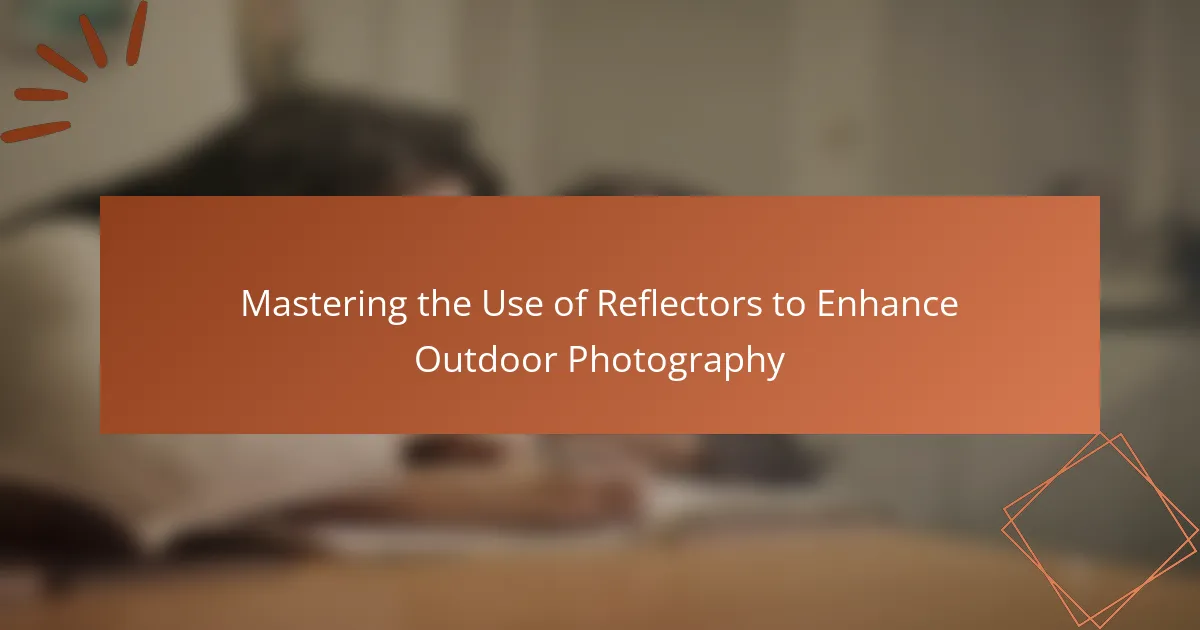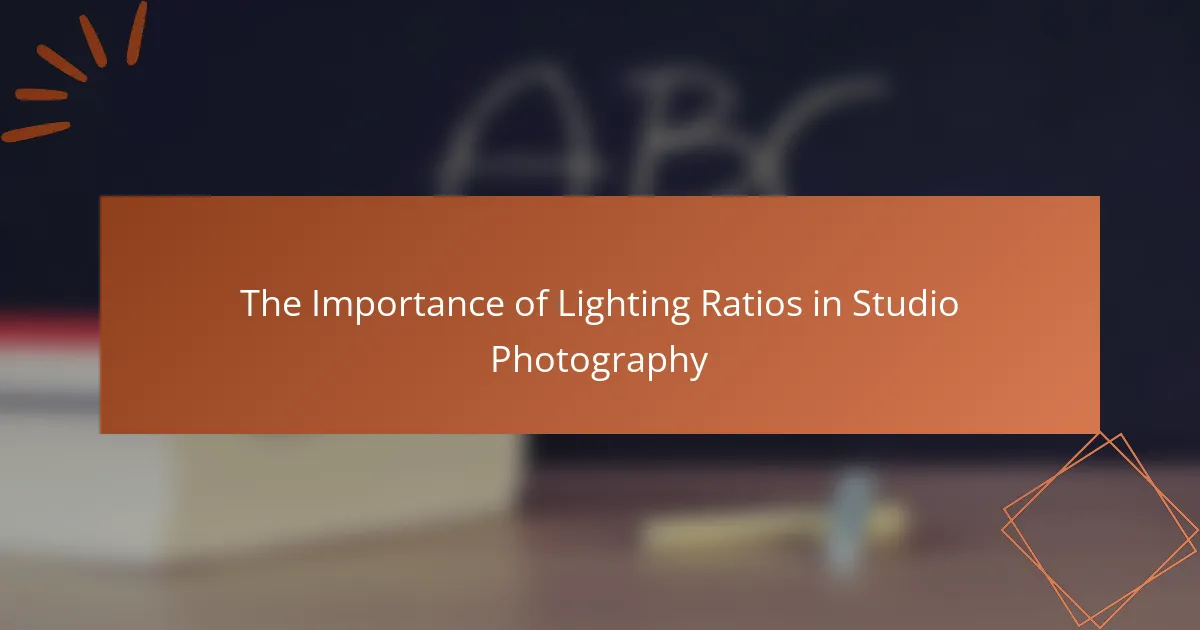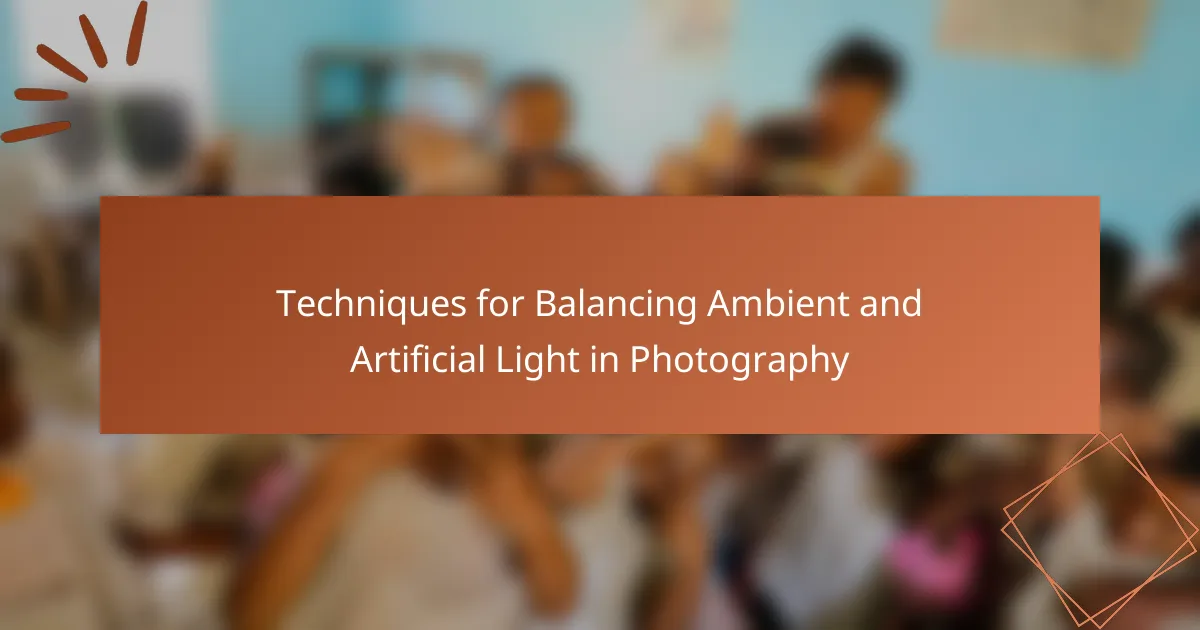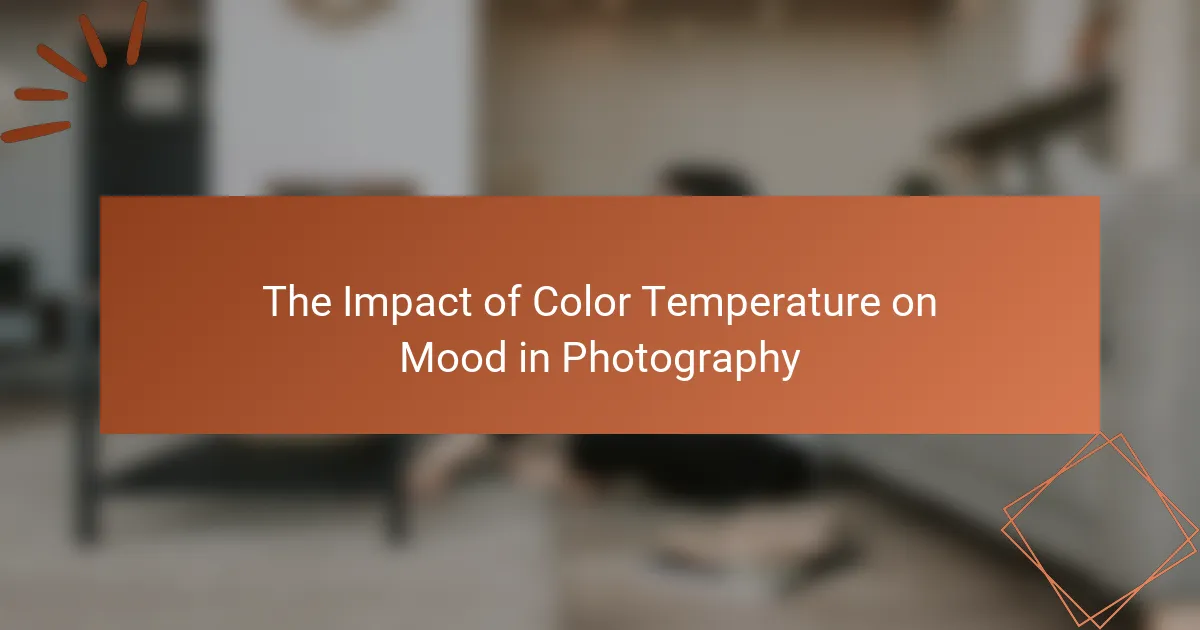The article compares two primary types of lighting used in photography and videography: continuous lighting and strobe lighting. Continuous lighting provides a steady source of illumination, allowing real-time adjustments and visibility, making it suitable for both beginners and experienced creatives. In contrast, strobe lighting delivers short bursts of high-intensity light, ideal for freezing motion and capturing fast-moving subjects with clarity. The article outlines the distinct purposes, advantages, and creative applications of each lighting type, highlighting their roles in enhancing visual effects and overall composition in photography and videography.
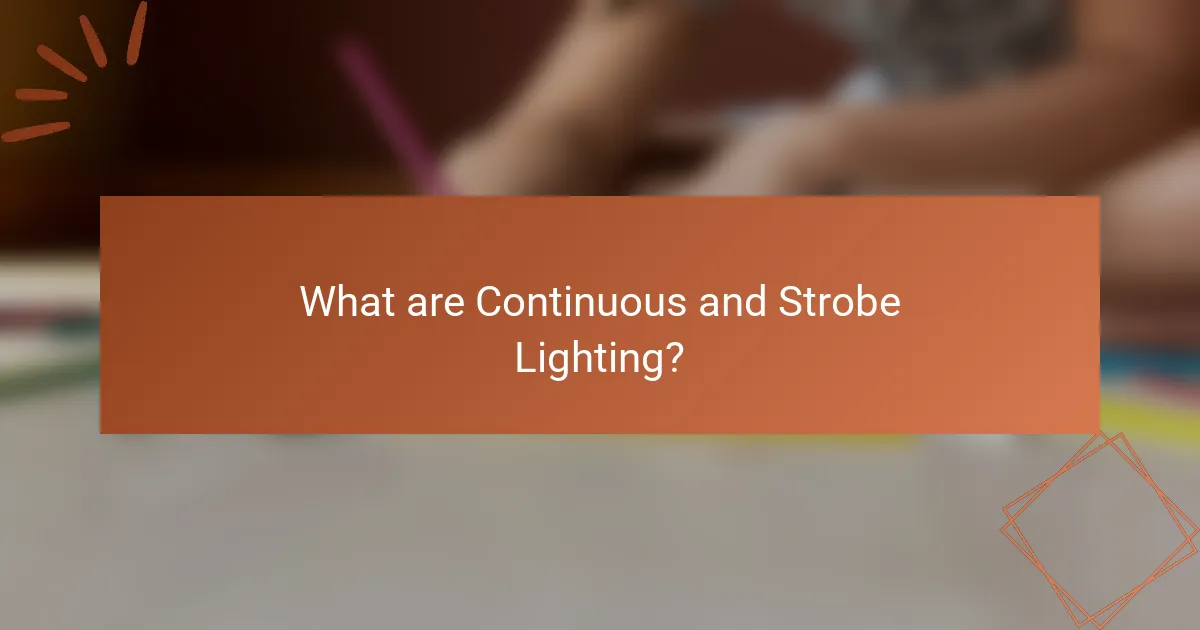
What are Continuous and Strobe Lighting?
Continuous lighting provides a constant source of illumination. It remains on during the entire shooting process. This type of lighting is ideal for video production and still photography. It allows photographers to see how the light affects the scene in real time. Common examples include LED panels and tungsten lights.
Strobe lighting, on the other hand, produces brief bursts of light. This type of lighting is typically used in photography. Strobes freeze motion effectively, making them suitable for capturing fast-moving subjects. They can produce a high-intensity light output for a short duration. Photographers often use them with modifiers like softboxes for softer light.
Both types of lighting serve distinct purposes in creative settings. Continuous lighting offers ease of use and visibility, while strobe lighting excels in freezing motion and creating dramatic effects.
How do Continuous and Strobe Lighting differ in functionality?
Continuous lighting provides a constant source of illumination. It allows photographers to see the light effect in real-time. This type of lighting is often used in video production and photography for its ease of use. Strobe lighting, on the other hand, emits short bursts of intense light. It is ideal for freezing fast motion and creating dramatic effects. Continuous lighting typically requires longer exposure times. Strobe lighting can achieve proper exposure with shorter times. This difference in functionality influences the choice of lighting based on the specific needs of a shoot.
What are the key characteristics of Continuous Lighting?
Continuous lighting provides a constant light source for photography and videography. It allows for real-time adjustments of exposure and lighting effects. This type of lighting is typically used in studio settings. Continuous lighting systems often use LED or fluorescent bulbs. They produce soft, even light that minimizes harsh shadows. This lighting allows for easier subject visibility and composition. Continuous lighting is versatile and can be used for various shooting scenarios. It is particularly beneficial for beginners who need to understand lighting dynamics.
What are the key characteristics of Strobe Lighting?
Strobe lighting is characterized by its ability to produce brief, intense bursts of light. This type of lighting is commonly used in photography and videography to freeze motion effectively. Strobe lights can have adjustable power settings, allowing for control over the light output. They typically have a short duration, often measured in milliseconds, which enables capturing fast-moving subjects without blur. Strobe lights can also be synchronized with camera shutters, enhancing their effectiveness in capturing sharp images. The light they emit is usually very bright, making them suitable for various creative effects. Strobe lighting is often portable, which adds to its versatility in different shooting environments.
What creative effects can be achieved with each type of lighting?
Continuous lighting creates a steady illumination that allows for real-time adjustments. It enables photographers to see how shadows and highlights fall on subjects. This type of lighting is excellent for video production due to its constant nature. It can produce soft, diffused light when used with softboxes, enhancing skin tones.
Strobe lighting, on the other hand, produces brief bursts of intense light. This type of lighting is ideal for freezing fast motion in photography. Strobe lights can create dramatic shadows and highlights, emphasizing textures. They allow for high-speed sync, enabling photographers to shoot with wide apertures in bright conditions.
Both types of lighting can be manipulated with modifiers to achieve various creative effects. For example, grids and snoots can direct strobe light for focused beams. Diffusers can soften continuous light for a more flattering look.
How does Continuous Lighting contribute to creative photography?
Continuous lighting enhances creative photography by providing a constant light source. This allows photographers to see how light interacts with subjects in real-time. It facilitates easier adjustments to lighting angles and intensities. Photographers can experiment with shadows and highlights effectively. Continuous lighting is particularly beneficial for video shoots, where consistent illumination is crucial. Additionally, it simplifies the process of capturing ambient light. The ability to visualize lighting setups aids in achieving desired artistic effects. Studies show that continuous lighting can improve creativity by reducing the guesswork associated with exposure settings.
What unique effects does Strobe Lighting enable in creative projects?
Strobe lighting enables unique effects such as freezing motion and creating dramatic visual impacts. It allows photographers and videographers to capture sharp images of fast-moving subjects. The rapid bursts of light can highlight specific details that continuous lighting might miss. Strobe lighting also enhances the contrast between light and shadow, adding depth to images. This technique is often used in fashion and sports photography to emphasize movement and energy. Additionally, strobe lighting can create a sense of rhythm in visual storytelling. It is effective in creating light trails and other artistic effects in long exposure photography. These attributes make strobe lighting a versatile tool in creative projects.
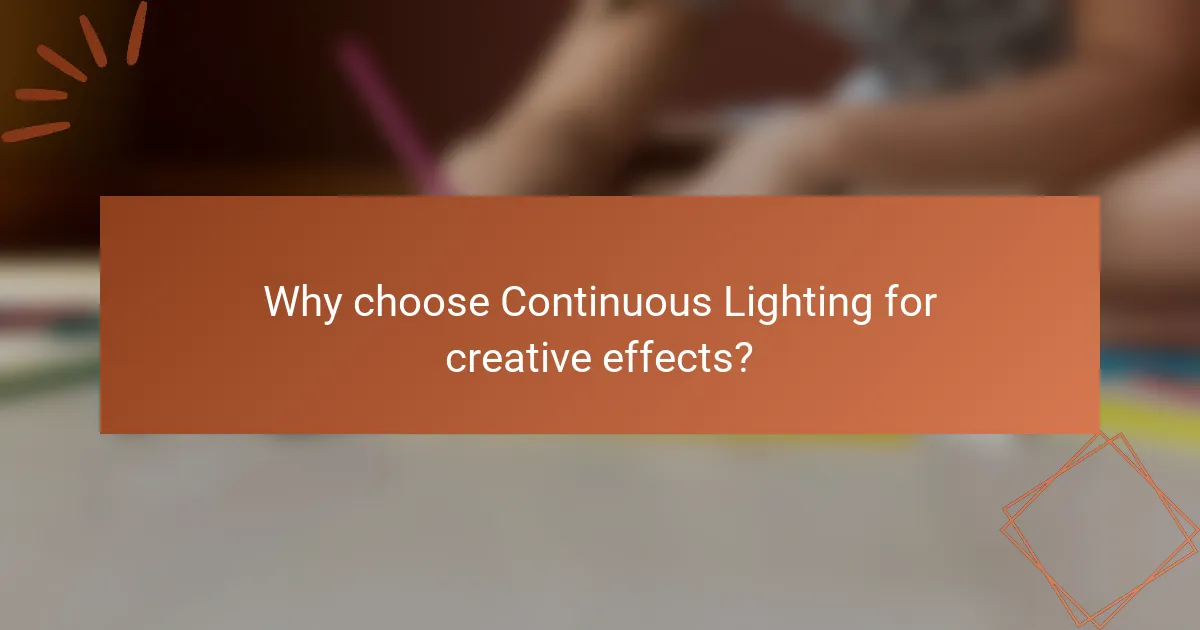
Why choose Continuous Lighting for creative effects?
Continuous lighting is preferred for creative effects due to its consistent illumination. It allows artists to see the effects of lighting in real-time. This immediate feedback aids in adjusting light angles and intensities. Continuous lighting is versatile for various settings, including photography and videography. It simplifies the lighting setup process, making it accessible for beginners. Additionally, it enables the use of various modifiers like softboxes and umbrellas. This adaptability enhances creativity in achieving desired looks. Continuous lighting also eliminates the need for synchronization, which is often required with strobe lights.
What are the advantages of using Continuous Lighting?
Continuous lighting provides consistent illumination, enabling photographers to see the lighting effects in real-time. This allows for precise adjustments during shooting. It simplifies the setup process, as there is no need to sync with a camera’s shutter speed. Continuous lighting is user-friendly, making it suitable for beginners. It also enhances video production by providing steady light throughout the recording. Additionally, continuous lighting is versatile and can be used in various environments. Its ability to create soft shadows and even lighting improves the overall quality of images. These advantages make continuous lighting a popular choice among photographers and videographers.
How does Continuous Lighting enhance the creative process?
Continuous lighting enhances the creative process by providing consistent illumination that allows for real-time adjustments. This type of lighting enables artists to visualize the effects of light on their subjects instantly. Unlike strobe lighting, continuous lighting eliminates the guesswork in exposure settings. It allows creators to experiment with shadows and highlights effectively. This adaptability fosters creativity by encouraging spontaneous decisions during shoots. Additionally, continuous lighting is beneficial for video production, as it maintains a stable light source throughout the recording. Its ease of use contributes to a more efficient workflow, enabling artists to focus on their creative vision.
In what scenarios is Continuous Lighting most effective?
Continuous lighting is most effective in scenarios requiring consistent illumination. It is ideal for video production, where stable lighting is crucial for capturing motion. This type of lighting is also beneficial for photography in controlled environments. Subjects can be seen in real-time, allowing adjustments before capturing the image. Continuous lighting works well in portrait photography, as it helps in achieving desired shadows and highlights. It is particularly useful in macro photography, where precise lighting is essential. Additionally, continuous lighting is advantageous for beginners, as it simplifies the exposure settings. Overall, its versatility makes it a preferred choice in various creative settings.
What are the limitations of Continuous Lighting?
Continuous lighting has several limitations. It typically generates more heat than strobe lighting. This can lead to discomfort for subjects and equipment overheating. Continuous lighting also requires higher power consumption, which can be inefficient. The light intensity may not be sufficient for fast-moving subjects, resulting in motion blur. Additionally, it can create unwanted shadows and reflections due to its constant illumination. Continuous lighting often lacks the versatility of strobe lighting in terms of flash duration and intensity control. Finally, it may require more complex setups to achieve desired effects in photography.
How does Continuous Lighting impact exposure and color accuracy?
Continuous lighting impacts exposure by providing a constant light source, allowing for real-time adjustments. This consistency helps photographers gauge exposure settings accurately. When using continuous lighting, the intensity of light directly influences the exposure level captured by the camera. Higher intensity results in brighter images, while lower intensity leads to darker images.
Color accuracy is also enhanced with continuous lighting. This type of lighting typically uses LED or fluorescent bulbs, which can emit a consistent color temperature. A stable color temperature ensures that colors appear true to life in photographs. For instance, daylight-balanced continuous lights have a color temperature of around 5500K, mimicking natural sunlight.
Furthermore, continuous lighting reduces the risk of color shifts that can occur with flash photography. Since the light is always on, photographers can see how colors will render before taking the shot. This visibility allows for better control over color grading during the shoot. Therefore, continuous lighting is beneficial for both exposure and color accuracy in photography.
What challenges might users face with Continuous Lighting?
Users may face several challenges with Continuous Lighting. One significant issue is heat generation. Continuous lights often produce a considerable amount of heat, which can be uncomfortable for subjects and may require cooling solutions. Another challenge is power consumption. Continuous lighting typically uses more energy than strobe lighting, leading to higher electricity costs.
Additionally, users may struggle with light intensity. Continuous lights can be difficult to control in terms of brightness, making it challenging to achieve the desired exposure. Color temperature consistency can also be problematic. Some continuous lights may shift in color temperature over time, affecting the overall quality of the images.
Moreover, the bulkiness of continuous lighting setups can hinder mobility. Users may find it challenging to transport and set up these lights in various locations. Lastly, continuous lighting can lead to unwanted shadows, which can complicate the lighting setup in a scene.
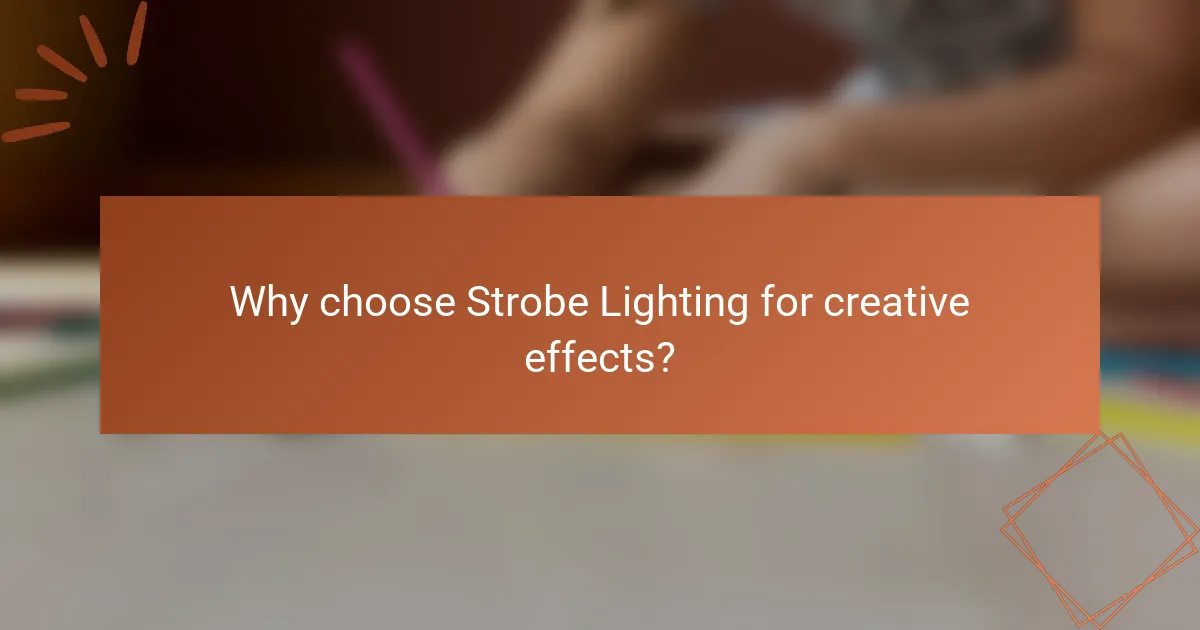
Why choose Strobe Lighting for creative effects?
Strobe lighting is chosen for creative effects due to its ability to freeze motion and create dynamic visuals. This type of lighting emits short bursts of light, allowing photographers to capture fast-moving subjects with clarity. Strobe lights can produce high-intensity illumination, which enhances details and textures in images. They also offer versatility in adjusting power settings, enabling various creative effects. Additionally, strobe lighting can create dramatic contrasts and shadows, enhancing the overall composition. Many professional photographers prefer strobe lighting for its reliability and consistency in various shooting conditions. This preference is supported by the fact that strobe lighting is widely used in high-end photography and commercial shoots.
What are the advantages of using Strobe Lighting?
Strobe lighting offers several advantages for photography and creative effects. It provides high-intensity bursts of light, allowing for quick exposure times. This capability freezes motion effectively, making it ideal for capturing fast-moving subjects. Strobe lights also enable greater control over lighting conditions. Photographers can adjust the power output, which enhances flexibility in various environments. Additionally, strobe lighting can create dramatic shadows and highlights. This adds depth and dimension to images. The ability to sync with high-speed shutter settings further enhances its effectiveness in dynamic situations. Overall, strobe lighting is a powerful tool for achieving creative visual effects.
How does Strobe Lighting create dynamic visual effects?
Strobe lighting creates dynamic visual effects by emitting brief, intense bursts of light. This rapid flashing can freeze motion, allowing for the capture of fast-moving subjects in sharp detail. The short duration of each flash can create a sense of movement and rhythm in photography and videography. Additionally, strobe lighting can highlight specific elements in a scene, enhancing contrast and depth. The ability to control the frequency and duration of the flashes allows artists to manipulate visual perception creatively. Studies show that strobe lighting is effective in various settings, from dance performances to sports photography, where capturing action is essential.
In what scenarios is Strobe Lighting most effective?
Strobe lighting is most effective in scenarios requiring high-speed photography or freezing motion. It captures fast-moving subjects sharply, making it ideal for sports and action photography. Strobe lights provide a brief burst of intense light, which can illuminate a scene without motion blur. This technique is essential in fashion shoots to highlight details in fabric movement. Additionally, strobe lighting is beneficial in low-light environments, enhancing visibility without increasing exposure time. Its versatility is evident in events like concerts, where dynamic lighting enhances the atmosphere. Studies show that strobe lighting can achieve faster shutter speeds, resulting in clearer images of rapid movements.
What are the limitations of Strobe Lighting?
Strobe lighting has several limitations. It can produce harsh shadows due to its brief flash duration. This can lead to unflattering lighting in some scenarios. Strobe lights also require a specific synchronization with the camera shutter. If not timed correctly, images may appear underexposed or miss the action. Additionally, strobe lights can be distracting to subjects, especially in a fast-paced environment. They may also cause discomfort or disorientation due to their intense flashes. Lastly, strobe lighting generally requires additional equipment, such as triggers or sync cords, adding to the complexity of setup.
How does Strobe Lighting affect the workflow during shoots?
Strobe lighting significantly enhances workflow during shoots by providing quick bursts of light. This type of lighting allows photographers to freeze motion effectively. It enables precise control over exposure settings. Strobe lights can be adjusted for varying intensity and duration. This flexibility aids in achieving desired creative effects. Additionally, strobe lighting reduces the risk of overheating during long shoots. It also minimizes the need for constant adjustments, streamlining the shooting process. Overall, strobe lighting contributes to a more efficient and productive photography workflow.
What technical challenges can arise with Strobe Lighting?
Strobe lighting can present several technical challenges. One challenge is synchronization with camera shutter speed. If the shutter speed is too fast, the strobe may not fully illuminate the subject. Another issue is power management. Strobe lights require significant power, which can lead to overheating if not managed properly. Additionally, strobe lights often have a limited recycle time. This can restrict the frequency of flashes during high-speed shooting.
Color temperature consistency is another challenge. Strobe lights can vary in color output, affecting the overall image quality. Lastly, the need for precise positioning can complicate setup. Incorrect placement can lead to unwanted shadows or uneven lighting. These challenges require careful planning and adjustment for optimal results.
How can you decide between Continuous and Strobe Lighting for your project?
To decide between Continuous and Strobe Lighting for your project, consider your specific needs. Continuous lighting provides a constant light source, making it easier for framing and focusing. It is ideal for video work and situations requiring consistent illumination. Strobe lighting, on the other hand, offers powerful bursts of light. This is beneficial for freezing motion and achieving high-quality images in photography.
Evaluate the type of project you are working on. If you need to capture fast action, strobe lighting is preferable due to its quick flash duration. Conversely, for projects that involve longer setups or video shoots, continuous lighting is more practical. Additionally, assess your budget and space. Continuous lights are often more affordable and require less setup space, while strobes may need additional equipment like triggers and modifiers.
Research indicates that photographers often choose strobe lighting for studio work due to its versatility and power (Source: “Lighting for Photography” by Mark Galer). Ultimately, your decision should align with the specific demands of your project and your workflow preferences.
What factors should influence your choice of lighting type?
The choice of lighting type should be influenced by the intended use, environment, and desired effects. Continuous lighting provides a constant source, making it easier to visualize shadows and highlights. This type is beneficial for video production and live settings where real-time adjustments are needed. Strobe lighting, on the other hand, delivers brief bursts of light, which can freeze motion effectively. It is ideal for photography, especially in capturing fast-moving subjects.
Another factor is the power output. Strobe lights typically offer higher wattage, allowing for greater versatility in various conditions. The color temperature is also crucial; continuous lights often have adjustable color settings, while strobes may require gels for color correction.
Portability can influence the choice as well. Continuous lights can be bulkier, while many strobe options are compact and battery-operated. Finally, budget considerations will affect the decision. Continuous lighting setups can be more affordable upfront, while strobe lighting may incur additional costs for accessories.
How can understanding the differences enhance your creative outcomes?
Understanding the differences between continuous and strobe lighting enhances creative outcomes by allowing for tailored lighting choices. Continuous lighting provides a constant source, enabling real-time adjustments and immediate visual feedback. This immediate feedback helps in making quick creative decisions during a shoot.
Strobe lighting, on the other hand, offers powerful bursts of light that can freeze motion and create dramatic effects. Knowing when to use each type can significantly affect the mood and style of the final image.
For example, continuous lighting is ideal for video work, as it mimics natural light. In contrast, strobe lighting is often preferred for photography due to its ability to create high contrast and highlight details.
Research shows that understanding these differences allows artists to manipulate light effectively, resulting in more impactful visual narratives. A study by the American Society of Media Photographers highlighted that 78% of photographers reported improved creative results when they mastered different lighting techniques.
What are some best practices for using Continuous and Strobe Lighting effectively?
Use continuous lighting for consistent illumination and easy adjustments. This type allows photographers to see the effects in real-time. It is ideal for video shoots and product photography.
Strobe lighting provides powerful bursts of light. This makes it suitable for freezing motion in dynamic scenes. Use strobe lights to create dramatic effects with shadows and highlights.
Position lights at different angles to enhance depth. Experiment with modifiers like softboxes and umbrellas for softer light.
Adjust the power settings to control exposure and maintain detail. Use a light meter to ensure accurate readings.
Consider ambient light conditions when setting up. This helps in balancing the artificial light with natural sources.
Utilize triggers and remote controls for strobe lights. This allows for greater flexibility in positioning.
Test different setups before the final shoot. This ensures desired effects are achieved.
The main entity of the article is the comparison between Continuous and Strobe Lighting in the context of creative effects. The article outlines the functionalities, characteristics, advantages, and limitations of both lighting types, emphasizing their distinct purposes in photography and videography. Key points include the real-time visibility and ease of use of Continuous Lighting versus the high-intensity bursts and motion-freezing capabilities of Strobe Lighting. Additionally, the article discusses scenarios where each type is most effective, best practices for usage, and factors influencing the choice of lighting for specific projects.
